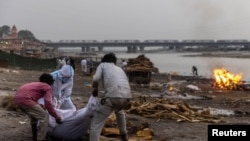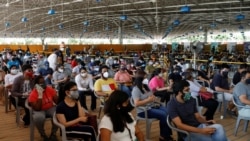On May 17, as India continued to be crushed by the coronavirus pandemic, S. Vishnu Vardhan Reddy, the Bharatiya Janata Party (BJP) general secretary for the state of Andhra Pradesh, tweeted praise for the authorities' vaccination campaign.
“Till date we have vaccinated 18cr+ [180 million+] Indians. Free vaccines for 45+ age group. Free ration to 80cr+ people for months,” he wrote, adding that “this was possible just because of our PM Shri,” meaning Prime Minister Narendra Modi.
Reddy’s tweet is misleading: 180 million+ is an estimate of the number of doses that have been administered in India so far, not the number of people vaccinated.
According to Our World in Data, as of May 18, 144.1 million people had received at least one shot of the vaccine. Out of the 144.1 million, 40.9 million – only about 3 percent of India’s population – had received both shots.
So, while 185 million COVID-19 vaccine doses have been administered, fewer people have been vaccinated than Reddy claimed.
India is a leading maker of vaccines, and joined the World Health Organization’s COVAX program in partnership with other U.N. bodies and Gavi, an alliance to help get COVID-19 vaccines to low- and middle-income countries. In early March, it donated 150,000 doses to Iran through the program.
But simultaneously, the country has failed to control the coronavirus pandemic, largely because of domestic vaccine shortages.
“Even if the projected supply was available, India has opened the vaccination to a far bigger population than probably any setting can expect the vaccines [to cover],” Dr. Chandrakant Lahariya, a New Delhi doctor and expert on vaccines, public policy and health systems, told CNBC. “It is essentially an outcome of limited supply and a vaccination policy which is not mindful of supplies.”
As the Quartz business website reported, “tracking events over the past year reveals a timeline of dysfunction: a period in which government negligence, corporate profiteering, opaque contracting, and the inequities of the global pharma market combined to bring India to this moment of vaccine crisis.”
In January, Indian regulators approved the Covishield and Covaxin vaccines for use. India then placed its first vaccine orders, for 11 million doses of Covishield and 5.5 million doses of Covaxin – an extremely small number considering the country’s population.
KV Balasubramaniam, who formerly headed Indian Immunologicals, a vaccine manufacturer, estimated that “to achieve herd immunity in a year, taking into account a 5% wastage margin, India needs about 200 million doses per month,” as Quartz wrote.
In February, the government ordered another 10 million doses of Covishield and 4.5 million doses of Covaxin. Meanwhile, India was exporting tens of millions of doses to countries in Africa and Latin America, as well as Caribbean Middle East and Pacific Island states.
In late March, India temporarily halted its participation in the COVAX program in order to address a domestic shortage of vaccines amid a surge of new COVID-19 infections.
Also in March, the government made its first big order – for 100 million Covishield doses and 20 million Covaxin doses. However, by that time, India was already facing the start of a second wave of the COVID-19 pandemic, with cases rising extremely fast and devastating the nation. In early April, India was seeing more than 150,000 new cases daily. By May, the number reached 400,000 – compared to less than 20,000 in January and February.
The sharp increase was due to "a false sense of normalcy [which] crept in and everybody, including people and officials, did not take measures to stop the second wave,” Dr. A Fathahudeen, a member of India’s Kerala state's Covid taskforce, told BBC News. Most public places reopened, transportation resumed operating at full capacity, and religious ceremonies and festivals, as well as election rallies, took place.
On May 20, India set a world record for COVID-19 deaths, recording more than 4,500 deaths in a single day. However, experts say that number is a small fraction of the coronavirus toll in the country, given gross undercounting.
The World Health Organization recently declared India’s coronavirus variant – which was first discovered in October 2020 and is known as B.1.617.2 – a “variant of concern at the global level.” Preliminary studies found that the Indian variant spread more easily than the original virus.
To date, India has recorded over 26 million coronavirus cases and more than 291,300 deaths.







